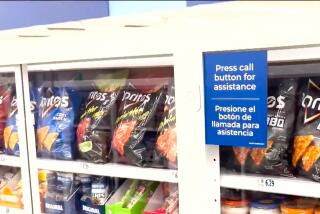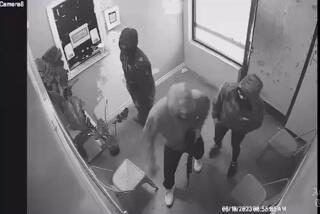Drugstores Find Niche in Making Custom Medications : Health: Small businesses survive by a return to early practice of offering specially blended compounds.
- Share via
Harking back to the days of the Main Street apothecary shop, some retail pharmacists are turning to compounding specialty prescriptions for patients as they compete in a market dominated by managed care companies and chain-owned drug supermarkets.
Corner drugstores across the country have closed at an astounding rate this decade. But an increasing number nationwide--including nearly 100 in Orange and Los Angeles counties--have carved out a profitable niche as providers of made-to-order medicines, candy-flavored prescriptions for children and even pet-friendly drugs that taste like chicken or fish.
These so-called compounding pharmacies recall an earlier time when druggists manufactured their own tinctures and emulsions, or ground prescriptions using a mortar and pestle. Today, the technique is decidedly modern, using such tools as electronic scales that measure drugs to within one-thousandth of a gram.
Compared to the assembly line practice common at chain pharmacies, “this is much more rewarding,” said Sylvia Moore, pharmacist manager at the Costa Mesa Pharmacy. “This is the way it is supposed to be. We spend a lot of time counseling the patient. We follow up on the phone. We have a goal of making them feel better.”
This back-to-the-future trend is spreading. The Professional Compounding Centers of America had 30 members in 1981 when it started; there are 2,500 throughout the nation today. The group, which provides education, training, equipment and supplies for compounding pharmacies, has 280 members statewide, including 41 in Los Angeles County and 48 in Orange County. There are about 3,800 pharmacies of all kinds in California.
Besides providing professional fulfillment, compounding is lucrative. In recent years, profit margins for drugstores have been squeezed by drug management companies, which handle prescription benefits for large health insurance companies.
Druggists often get paid as little as $1.75 to $2 above cost by a managed care firm to fill a $100 prescription, which commonly involves labeling and filling the medicine bottle from wholesale lots and checking for dangerous drug interactions, said industry experts. Pharmacies are forced to make their money with volume, with druggists commonly asked to fill more than 100 prescriptions daily.
Compounded medicines, however, are always made to order from a doctor’s prescription. Typically, the formulation involves a customized dosage, flavoring or method of delivery.
The profit margins for compounded medicines are typically 200% of raw material cost, said Robert Quint, owner of the Costa Mesa Pharmacy, with 75% of the prescriptions covered at least in part by insurance.
“It is a creative way to prescribe and provide for the delivery of medications,” said Dr. Alan Green, a family practitioner in Fountain Valley who often sends patients to compounding pharmacies. “Sometimes medications [taken orally] will have unwanted side effects on the rest of the body, when you really only need it for a localized area.”
Compounders will also formulate a salve or lozenge to provide direct absorption through the skin or mucous membranes of medicines that otherwise would be altered or destroyed by the digestive tract or the liver. They supply medications that worked well for a particular patient but are no longer available from major pharmaceutical houses. They often trim or tailor dosages for children or people with particular conditions or sensitive systems.
“The large companies don’t do this,” Green said.
For instance, Moore’s pharmacy created a very high-dose, candy-flavored solution of vitamin B6 for an infant with a genetic disorder. The baby required 100 times the normal dose of B6 and without it suffered convulsions and developmental problems, said Dr. Jacqueline Kovacs, a pediatric neurologist at UCLA’s Mattel Children’s Hospital.
The alternative was daily injections of B6, because ready-made vitamin formulations were not precise enough, she said.
“They took the pure [B6] powder and created a precise dose in a liquid form that the baby could take, so we were sure he was getting the right amount of medicine,” Kovacs said.
A growing specialty is pet care, including treatment for cancers, high blood pressure and thyroid problems, and providing medicines for exotic species. That is when flavors such as celery or guava come in handy.
“Cats are very particular,” said Kaye Gornall, a pharmacist in West Los Angeles. “I have one that likes bubble gum.”
For the compounders, their specialty has been a saving grace. Since 1990, about 11,000 independent pharmacies have closed nationwide, a decline of 30%, according to Todd Dankmyer of the National Community Pharmacists Assn. in Washington. In California, nearly 700 closed this decade.
The survivors have found specialty niches where they can excel doing things the chains do not do, said pharmacy experts.
Compounding is especially suitable because reimbursements are not strictly defined. “There is not a book where you can look up the price,” said Elizabeth Johnson, spokeswoman for the California Pharmacists Assn. in Sacramento. “The pharmacist really sets the price.”
For Gornall, the Westside druggist, being able to practice the old craft of pharmacy the way she was taught 25 years ago is just part of the reward.
“I actually enjoy the compounding itself,” she said. “I also get a lot more interaction with patients, discussing with them whether it is working and how we can change it and seeing results. You get better absorption, and patients are adhering to therapy. . . . Overall, you are getting better results.”
More to Read
Inside the business of entertainment
The Wide Shot brings you news, analysis and insights on everything from streaming wars to production — and what it all means for the future.
You may occasionally receive promotional content from the Los Angeles Times.










